Commercial Roof Maintenance Checklist
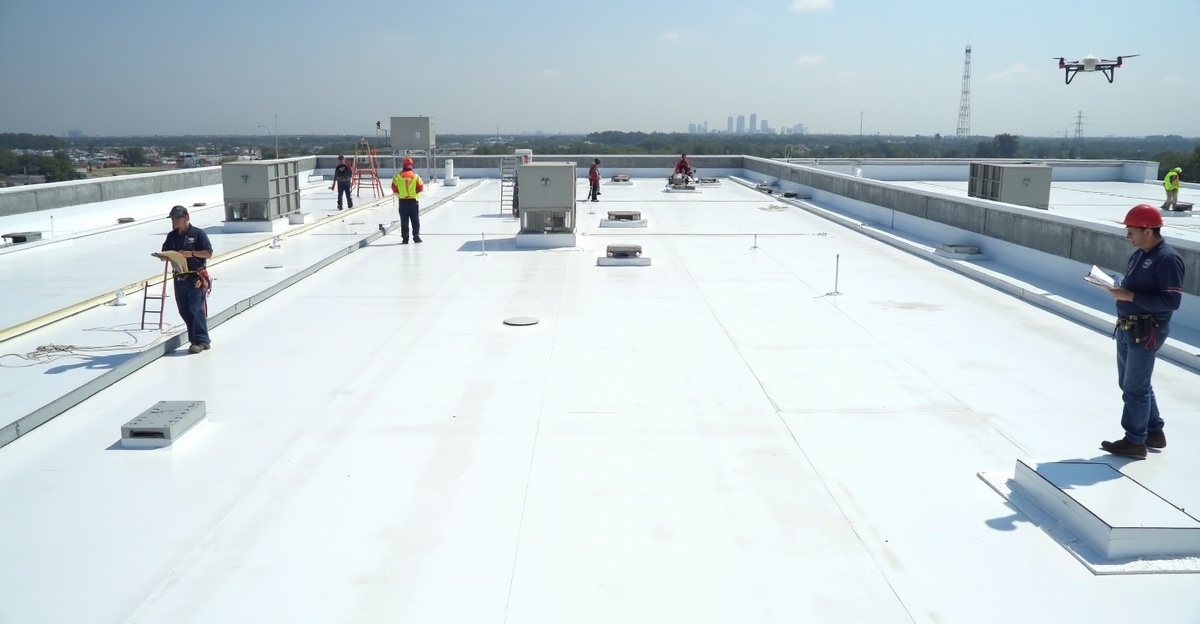
A smart commercial roof maintenance plan does more than stop leaks—it shields your budget, safeguards your warranty, and supports peace of mind. This checklist outlines what to check and when, helping extend your roof’s life while cutting down on risk and surprise costs.
Key Takeaways
- Skipping regular inspections can void warranties and lead to expensive repairs—sometimes reaching tens of thousands of dollars.
- A solid maintenance plan includes monthly surface reviews, quarterly checks for seams and penetrations, and yearly inspections by certified professionals.
- Warning signs like standing water, blistered membrane, or lifted flashing require urgent action before they grow into larger issues.
- Each roof system—flat, metal, or built-up—needs a specific plan based on how its materials respond to movement and climate.
- Internal teams can handle debris cleanup and record-keeping with photos, but only licensed technicians should perform inspections, repairs, and warranty-related work.
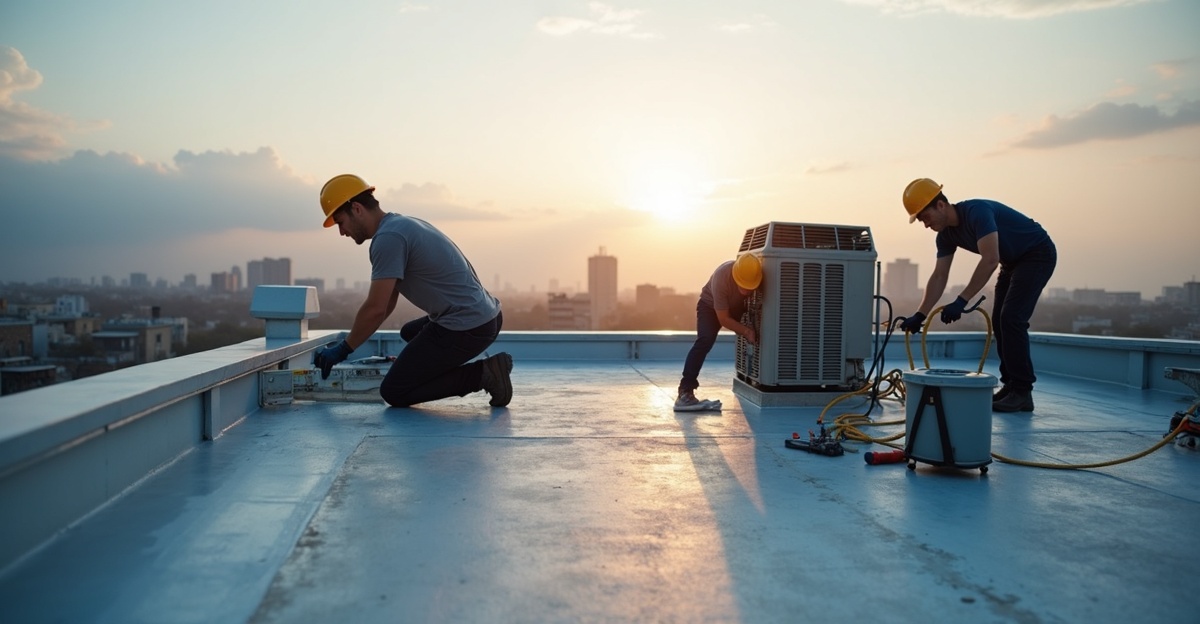
What’s at Stake: Why Commercial Roof Maintenance Isn’t Optional
Repair Costs and Shortened Lifespan
We’ve seen firsthand what happens when commercial roof upkeep gets ignored. Problems pile up fast—and they’re expensive. Without routine maintenance, a commercial roof can lose up to half of its service life. That’s 10 to 15 years lost on systems meant to last 20–30. Once damage sets in, repairs don’t come cheap. Common issues like ponding water, membrane splits, or failed flashing often lead to repairs ranging between $10,000 and $30,000. In some cases, it’s even more.
Proactive care saves money. Regular checkups and early fixes can extend a roof’s useful life by up to 30%. Stretching those extra years out of your investment means avoiding early replacement and keeping long-term budget plans intact.
When we talk with long-term clients, their consistent feedback is simple: scheduled maintenance reduces emergencies, energy loss, and stress. And as far as ROI goes, very few building investments beat a well-maintained roof.
Warranty, Liability, and Business Disruptions
Let’s get clear on what voids most warranties: skipped inspections, unaddressed leaks, and missing documentation. Roof warranty maintenance requirements often include at least one professional inspection per year and immediate follow-up on any signs of deterioration. Miss one of those steps? The warranty may not cover damage, even if it’s major.
Failing to stick to scheduled maintenance does more than impact coverage—it shifts the liability onto facility managers or building owners. That could mean footing the bill for a full replacement, even when the issue could’ve been caught earlier. For a mid-size building, that can easily run over six figures.
More than just paperwork, routine service keeps operations running. Sudden leaks disrupt business. Wet insulation ruins HVAC efficiency. In severe cases, unresolved structural weaknesses can even risk safety violations. We’ve helped clients avoid shutdowns just by catching a problem during a scheduled visit. Simple care keeps your building code-compliant, insurable, and open for business.
And no, roof maintenance isn’t just about cleaning out the drains and walking away. Good upkeep protects more than surfaces. You’ll likely improve:
- Energy efficiency by sealing gaps and preserving insulation.
- Indoor air quality by preventing moisture intrusion and mold.
- Safety ratings and insurance premiums by maintaining a secure envelope.
Solid maintenance isn’t optional—it’s a requirement if you’re thinking long-term.
Here’s a look at what we regularly cover for commercial clients:
- Annual and post-weather event inspections to stay ahead of trouble.
- Documentation to support manufacturer warranties and liability protection.
- Sealant touch-ups, debris removal, and drainage checks to prevent premature wear.
- Review of rooftop accessories like HVAC curbs and skylights for weak points.
- Photo documentation and repair logs for bids, insurance, and warranty claims.
These aren’t add-ons—they’re the basics of structured commercial roof maintenance. And if your roof is a built-up system, this built-up roof maintenance guide has extra pointers.
Whether it’s cap sheet blisters or loose flashing seams, regular upkeep helps spot issues before they multiply. If inspections aren’t happening at the right frequency, this is a good time to check how often a commercial roof should be inspected.
Letting things slide means higher repair costs, lost warranty protection, and big hits to your operating budget. We’ve seen the damage—and we’ve also helped clients stay ahead of it with consistent care. A trustworthy maintenance plan protects your investment, gives you peace of mind, and keeps your building working for you.
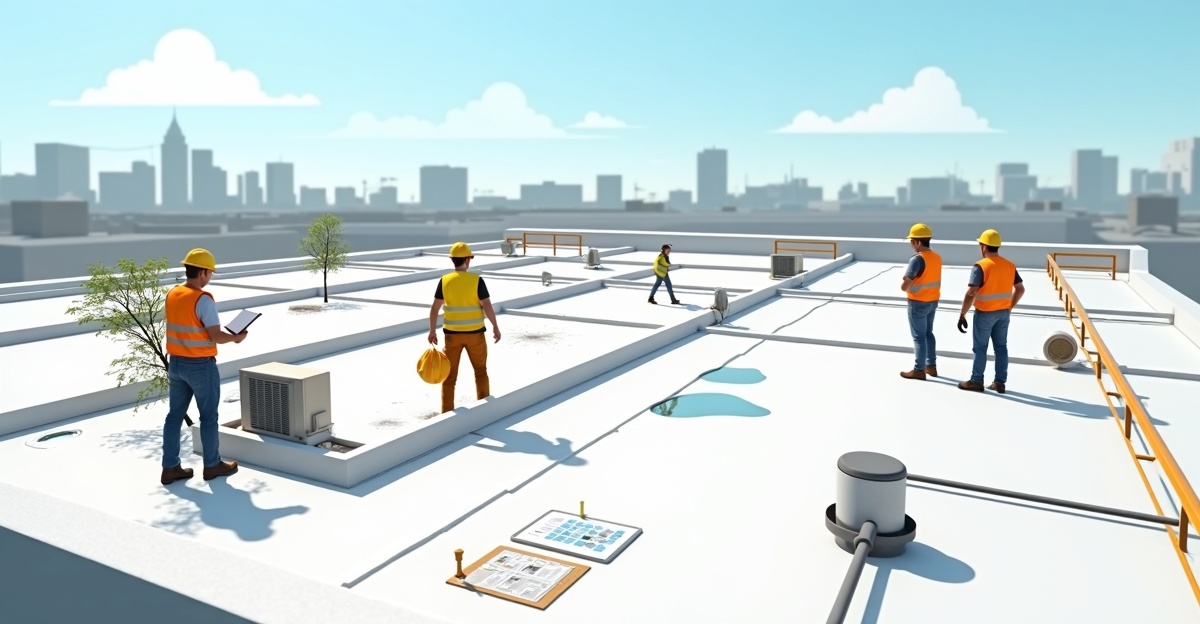
The Core Checklist: What to Inspect and When
We stick to one rule: planned checks beat surprise repairs. A regular maintenance schedule prevents leaks, system failures, and expensive downtime. Here’s how we break down a solid commercial roof inspection checklist, with what to do and how often to do it.
Monthly and After Major Storms
You don’t need to wait long to see damage pile up. Small issues after a storm or just a month of neglect can grow into big repairs. Every month—and after any big weather event—make time to:
- Clear debris from the roof surface, especially branches, leaves, and trash blowing in from nearby lots.
- Make sure drains, gutters, and scuppers are free-flowing. Clogs trap water and cause pressure buildup.
- Watch for ponding water or standing puddles that stick around more than 48 hours. These are early warning signs your drainage may not be doing the job.
This is basic upkeep, but trust us—it makes all the difference.
Quarterly
Every 3 months, go deeper. These inspections help you stay ahead of leaks, structural wear, or past failed repairs. Here’s what to include:
- Check the flashing, membrane seams, and any patches. Look for punctures, open seams, blisters, or cracks.
- Inspect rooftop penetrations. That includes HVAC curbs, vent stacks, satellite bases—anything breaking the roof plane.
- Look for signs of animal nesting or vegetation starting to take hold. Both can lift or puncture your membrane.
Quarterly checks should be documented, especially if your building is under warranty. Photos and notes help justify service decisions and warranty claims.
Bi-Annual Checks
Every six months, it’s time for a deeper dive. We recommend property managers or maintenance chiefs walk the roof alongside a professional. Together, inspect:
- Insulation underneath for signs of saturation or damp staining.
- Skylights, turbine vents, flashing boots, and other accessories. These often crack or shift over time.
- Expansion joints and safety hardware like guardrails or anchor points. Roof movement or thermal cycling puts stress here—don’t ignore it.
This deeper inspection supplements short-term checks and prepares your roof for big seasonal shifts like harsh winters or thunderstorms.
Annual Survey
Lock in one full-scale professional inspection every year. At RayPro, we call this the top line on your annual commercial roofing checklist. Here’s what we include in our surveys:
- A full membrane assessment from edge to edge.
- Tests for proper drainage slope—especially on flat roofing systems where pooling hides easily.
- Review of past maintenance logs and service records.
- Check on warranty compliance. Some warranties require annual inspections to stay in effect. Don’t void your coverage by missing this step.
If you’re managing a flat roof system, annual reviews also help guide your long-term budget planning. You’ll know when it’s smarter to repair versus replace based on wear trends and system age.
For building owners or facility teams managing a built-up or metal system, you can use our expert tips like those in our built-up roof maintenance guide or this practical metal roof maintenance checklist.
If you’d rather keep everything handy, we’ve created a downloadable version of this Commercial Roof Maintenance Checklist. It’s easy to save, print, and bring on roof walks. You can grab the copy by heading to our contact page and requesting the maintenance checklist PDF.
For a deep inspection reference, bookmark our ultimate roof inspection checklist guide—it walks you through exactly what pros look for at each layer.
If you’re overseeing multiple sites, or simply want peace of mind that your team didn’t miss anything, talk to our crew. Our commercial roofing inspectors cover routine upkeep and provide repairs if we find trouble spots. Whether you maintain a single facility or manage a portfolio, we’re ready to help you protect your investment all year long.
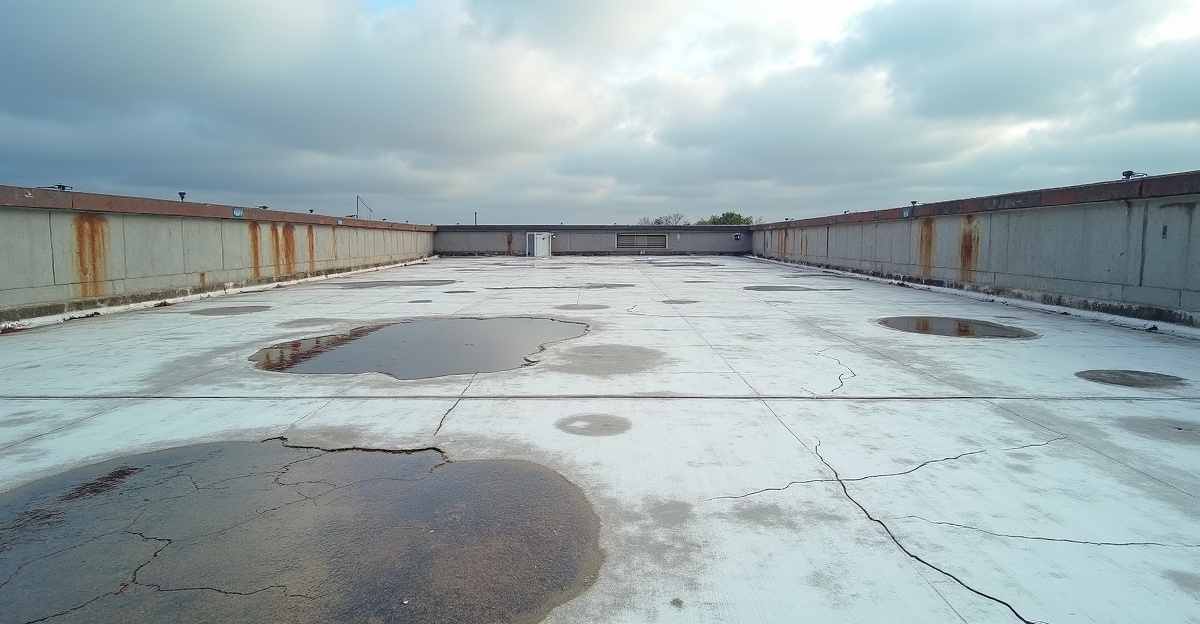
Know the Red Flags: Signs of Roof Damage You Can’t Ignore
Spotting early trouble on a commercial roof saves a lot of time and money down the line. Some warning signs show up clearly if you know where to look—and ignoring them can lead to major failures. We’ve dealt with every type of roof issue out there, and we’ve learned that small symptoms often hint at bigger problems hiding below the surface.
Key Signs of Commercial Roof Damage
Pay close attention to these telltale signs during routine checks or after storms:
- Water stains on ceilings or steel structures — These often trace back to slow leaks that travel far from the original breach. If you see discolored tiles or rusty trusses, it’s time for a closer look.
- Ponding water that lasts more than 48 hours — Standing water is a red flag for drainage or slope issues. On flat systems, we often find clogged scuppers or compressed insulation beneath problem areas.
- Loose edge flashing or lifted seams — Wind can break seals around the perimeter if flashing starts to pull away. Left unfixed, rainwater starts creeping in unnoticed.
- Bubbles, blisters, or “alligatoring” on the membrane — These surface issues point to trapped moisture or aging materials. That cracked, wrinkled look might also signal UV damage or adhesive failure.
- Mold smells or indoor discoloration — Musty, earthy odors usually mean leaks have gone unchecked too long. Moisture trapped in ceilings or walls often brings mildew and weakens interior finishes.
We also recommend using a structured plan like our roof inspection checklist to make sure nothing gets overlooked—especially on large buildings.
Why Small Issues Deserve Fast Action
Most leaks don’t start as floods. It’s usually a pinhole, slipped seam, or cracked seal that slowly wears away the system. What might look like a cosmetic issue—like bubbling or surface cracks—can signal deeper damage. Left alone, these conditions often worsen after just one season of sun and rain. That’s why we don’t wait.
If you run a facility where downtime is costly, or you’re managing multiple properties, early detection becomes even more critical. A few patches or targeted repairs now can extend your roof’s life for years. Consider reviewing our built-up roof maintenance tips if your building uses BUR systems—those types need specific care.
Whenever we see signs of commercial roof damage, we advise documenting them with photos and getting a professional opinion. If multiple symptoms appear, the roof’s reaching a point where patching might not be enough. That’s when you’ll want to talk with a crew who’s seen it all—whether it leads to a full roof replacement or focused repairs.
The sooner damage is addressed, the fewer surprises you’ll face later on.
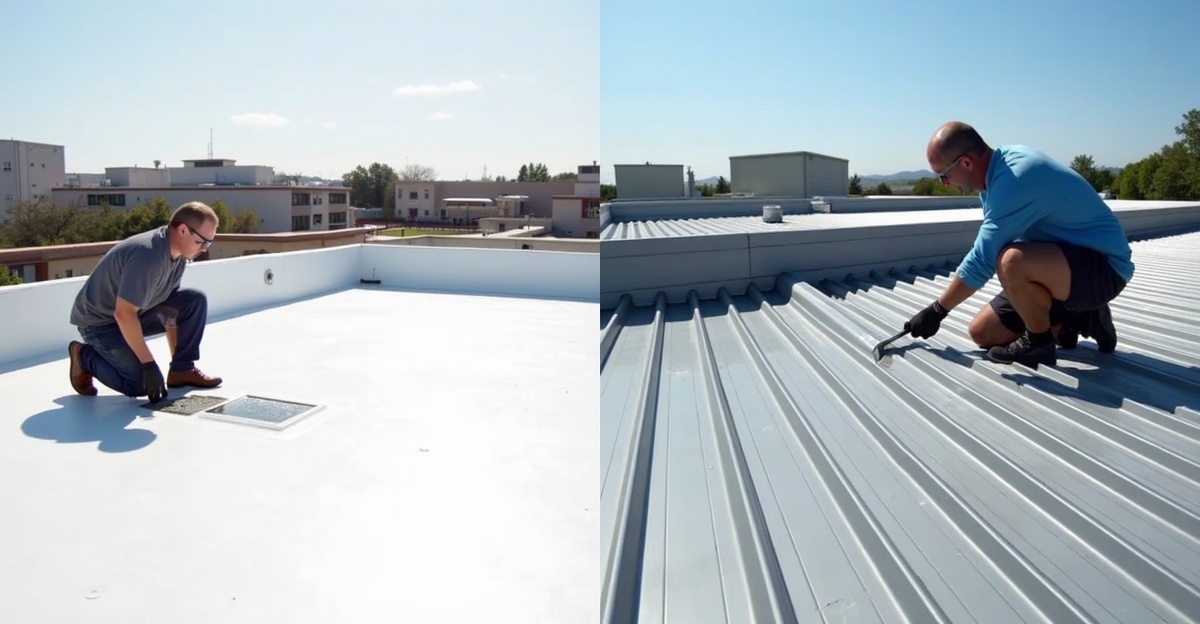
Tailored Advice for Roof Types: Flat vs. Metal and More
Not every roof wears the same boots. Different systems have their own quirks, weak spots, and maintenance needs. Whether we’re handling a TPO membrane or a standing seam metal system, staying on top of roof care means adjusting how we inspect and repair.
Flat and Low-Slope Roofs: Stay Ahead of Trouble
Flat roofs—especially TPO, EPDM, and modified bitumen systems—demand close attention. Their broad surface area and low drainage slope make them vulnerable to moisture, UV exposure, and mechanical damage. Focused flat roof preventive maintenance can keep problems from creeping in.
Here’s what we check on these systems:
- Seam Welds and Tie-ins: We look around wall transitions, skylight perimeters, and across flashing edges. These are common leak spots, especially if welds start to lift or separate.
- Membrane Damage: Blisters or splits signal either moisture stuck under the surface or UV stress over time. We patch early before the damage spreads.
- Drainage and Ponding: Blocked or slow drains lead to standing water. That adds stress and shortens the membrane’s service life. Regular cleaning helps us avoid this altogether.
- Shrinkage or Edge Pullback: With EPDM in particular, the membrane can pull tight over time, exposing seams. Re-securing edges protects insulation layers and reduces wind risk.
For a more detailed breakdown, this guide to maintaining a built-up roof membrane offers hands-on steps for keeping layered systems functional.
Flat roof materials are like sponges when neglected. Preventive maintenance cuts down on emergency calls and preserves the roof’s lifespan.
Metal Roofs: Watch the Joints and Movement
Metal roofs are strong, efficient, and long-lasting—but they’re still moving systems. Expansion, tightening, and fastener fatigue make regular checks essential.
Key areas we focus on include:
- Fasteners and Seams: Screws and rivets can loosen from stretching metal. When that happens, moisture sneaks into the insulation. We replace missing hardware, snug up loose panels, and tighten where needed.
- Rust Points: Coated metals resist corrosion well, but scratches around joints or mechanical penetrations start rust spots. We catch and treat these before rust opens up a seam.
- Sealant Life: Every joint and flashing connection relies on a flexible sealant to keep water out. Some last 10 years; others less. We monitor it seasonally and reapply before cracking or drying leads to failure.
- Movement Stress: Long panels expand and contract frequently. We inspect areas where panels may rub or bind, which can wear the finish and shorten panel life.
Because the surface is smooth, many metal roof issues hide in the joints. Staying ahead of them cuts down on long-term material fatigue. If it’s been a while, follow these metal roof maintenance tips to guide your inspection efforts.
Customize Maintenance to the System
There’s no one-size-fits-all checklist. Proper commercial roof care means adjusting based on the material, slope, and building use. That’s why we customize our approach every time we inspect.
Here’s how we keep your roof strategy sharp:
- Match inspection frequency to the material—flat roofs need more frequent visits than pitched systems.
- Use material-specific coatings and sealants for longer repair cycles.
- Apply reinforcement fabric at movement points on membranes, especially around HVAC curbs or ladder tie-ins.
- Don’t overlook utility penetrations—every cable, vent, or pipe is a chance for water to sneak in if the flashing fails.
If you’re checking your own property, this roof inspection checklist covers key points to review each season.
And remember: prevention outpaces repair. We recommend getting eyes on your roof proactively. This guide on how often commercial roofs need inspection can help with setting a schedule that fits your building and budget.
If you’d rather have the pros take care of it, our commercial roofing services are built around long-term protection, not short-term fixes.
Knowing how to maintain a commercial roof starts with knowing the system overhead. Whether it’s seams, screws, or sealants—it pays to stay alert and act before problems get expensive.
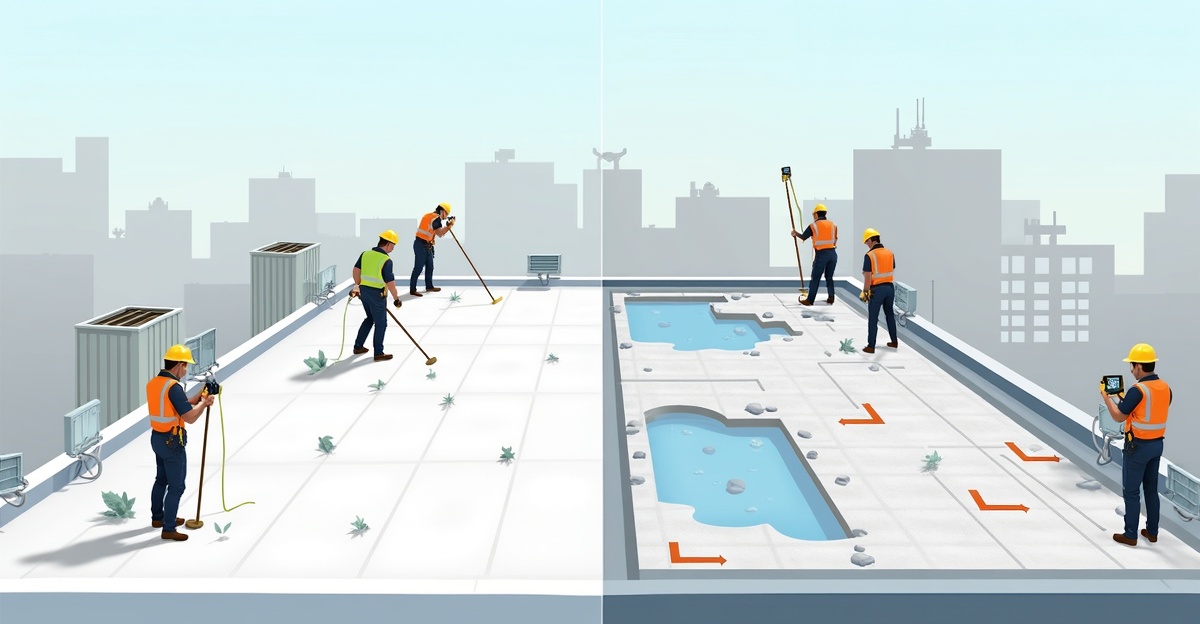
When to DIY and When to Call a Pro
Commercial roof upkeep is a team effort. While your facility or maintenance crew can manage routine checks and cleaning, some issues demand a trained eye and pro-grade tools.
What In-House Teams Can Handle
Maintenance staff are a valuable first line of defense. Here’s what they can—and should—stay on top of:
- Surface inspections after heavy weather or season changes
- Clearing off branches, leaves, and standing water
- Checking for blocked drains and downspouts
- Documenting wear and tear with photos and notes
- Keeping a consistent schedule for inspections and light upkeep
Tasks like these save money and catch problems early. If you’re tracking inspections already, this roof inspection checklist can tighten up that workflow with more structure.
When You Need a Commercial Roofing Contractor
There’s a line between safe maintenance and risky repairs. Cross it, and you’re looking at safety hazards, warranty issues, and ballooning costs. Call in a pro when:
- The roof membrane shows signs of splits, bubbles, or pooling below the surface
- There’s any sign of water intrusion or structural shifts
- Infrared scans, roof moisture surveys, or core samples are required
- Warranty terms call for inspections from certified contractors
- You’re unsure how to fix a problem as it develops
Even the best in-house crew can’t replace the tech and expertise of a certified commercial roofing contractor—especially one equipped to recognize hidden damage before it spreads.
We step in without overstepping. At RayPro, we don’t push full replacements when repairs make sense. And we don’t flood you with services you don’t need. Instead, we support your in-house team with what they can’t do alone—like infrared imaging or leak detection that doesn’t require tearing things up. We’re here to get the most out of the roof you’ve already invested in.
To keep your team sharp and your roof in shape, make sure you’re also following a regular program. These roof maintenance tips can help you hit the routine items consistently and avoid surprises.
When you do need backup, we’re ready. Just call.
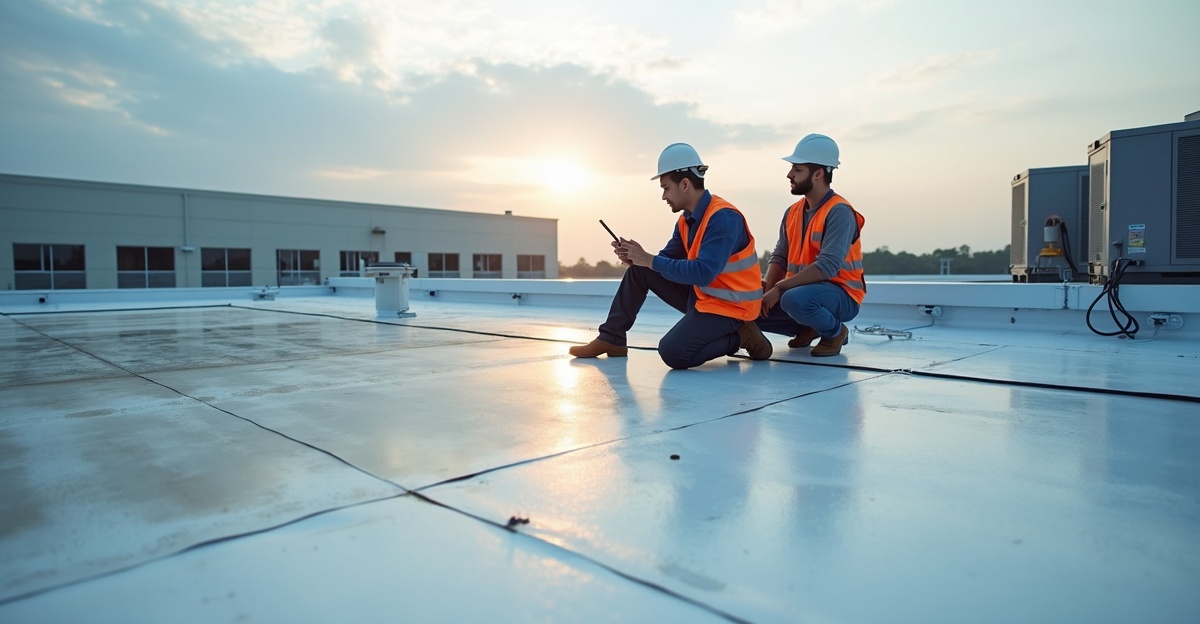
Protecting Your ROI: Maintenance as a Long-Term Investment
The Clear Payoff of Preventive Roof Maintenance
Commercial roofs take a beating—sun, rain, seasons, and foot traffic all take their toll. Skipping maintenance might save a buck upfront, but it ends up costing a lot more in the long run. A preventive approach offers real returns—anywhere from 2x to 5x ROI—by avoiding major breakdowns and unplanned capital expenses. That’s not theory; that’s what we’ve seen in action year after year.
Small problems like membrane blisters or clogged drains usually don’t announce themselves until they’ve caused interior damage or structural issues. Fixing these situations early is the easiest way to protect your budget. That’s the core of smart commercial roof upkeep: catching issues before they balloon.
Planned maintenance also supports building performance on the energy front. If you have a reflective, cool, or insulated system, keeping it clean and intact ensures your building doesn’t lose its R-value. Dirt, ponding water, or damaged coatings make your HVAC work harder—and your energy bills climb.
Insurers are paying attention, too. Properties with consistent documentation, professional inspections, and active maintenance programs in place often qualify for lower premiums. It’s a way for carriers to manage their long-term risks. For property owners, it’s a win-win: safer bets mean real savings over the policy term.
More Than Budget—It’s About Control
It’s not just about cutting costs. Planned maintenance puts you in control. Emergencies shift your day, force rushed decisions, and usually cost more in labor and materials. A smart maintenance checklist saves time and helps you plan work around business operations instead of scrambling outside normal hours.
Here’s what a proactive strategy helps you lock in:
- Consistent performance with fewer surprises
- No-code violations from deteriorated systems or missed inspections
- Warranty protection from manufacturers requiring yearly service records
- Avoidance of tenant disruptions or shutdowns due to leak emergencies
For property managers juggling multiple properties or large facilities, our roof maintenance tips for property managers simplify the workload. We know managing schedules, vendors, and budgets is hard enough—maintenance shouldn’t add friction.
Some systems need specialized care. For example, metal roofs need sealant checks and tightening. Built-up systems have their own patterns of wear—especially along seams and flashing. Every roof type demands a slightly different routine, and we build plans that reflect that.
We’re big believers in using a proven framework. Our techs follow a structured checklist based on industry-standard inspection practices, but we add local knowledge and experience to fit each specific building. That means tracking what actually matters on your site—not generic to-do’s.
We also recommend using our guide on how often your roof should be inspected to help set a smart annual schedule.
When it’s time for service—whether you’re dealing with cracked flashing, ponding water, or signs of age—we’re ready. Our team’s trained for everything from re-coating to long-life roof repair solutions. And if the roof’s lived past its time, we’ll work with you on your options before it starts costing more than it’s worth.
Planned maintenance doesn’t just stretch years off a roof’s lifespan—it gives you confidence in what’s over your head. We create custom commercial roof maintenance programs built around your operation, your schedule, and your business goals.
Let’s keep your roof working hard for your bottom line. Contact our team and we’ll talk through what program makes the most sense for your property.
